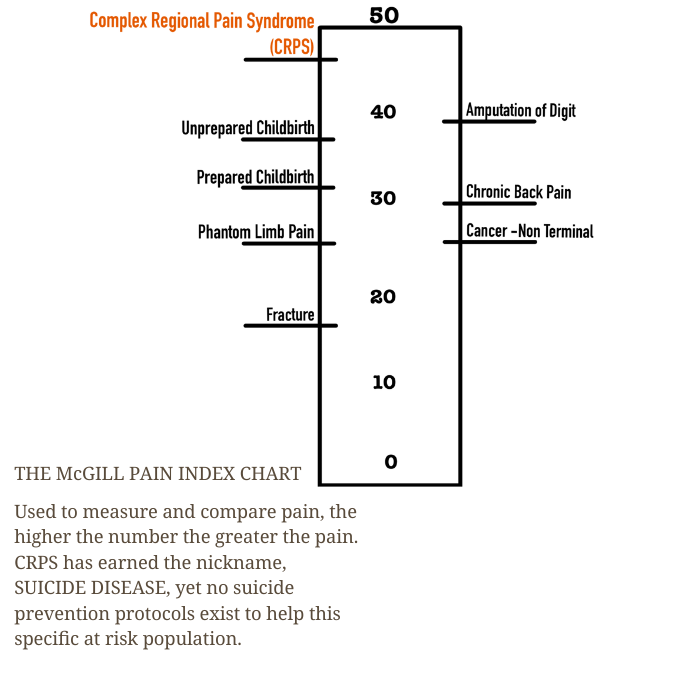
Complex Regional Pain Syndrome (CRPS), also known as Reflex sympathetic dystrophy (RSD) is a pain disorder in which the patient suffers from chronic pain and muscle damage, usually in an arm or leg. Although the exact cause of CRPS is unknown, doctors believe it is triggered when a person suffers an injury that damages the nerves. However, not all people who contract CRPS experienced an injury, and in these cases, doctors suspect the disease is related to an inappropriate immunological response. CRPS is also called Type I of complex regional pain syndrome.
What is CRPS?
Complex Regional Pain Syndrome



Symptoms of CPRS
CRPS damages the nerves. In a person with CRPS, the damaged nerves are unable to regulate blood flow properly. This causes the body to develop problems with blood vessels, bones, muscles, and skin. The symptoms of CRPS include bone and muscle pain, muscle spasms, discolored or thinning skin, intense skin sensitivity or burning sensations, increased perspiration, and swelling and stiffening of the joints.
Some CRPS sufferers experience chronic, yet manageable symptoms. However, more advanced CRPS can cause irreversible damage, such as muscle wasting, chronic muscle contracture (that leads to limited movement), and ongoing pain. Prognosis is dependent on when the disease is diagnosed. Without early intervention, CRPS can be crippling
Complex regional pain syndrome. An optimistic perspective, by Frank Birklein, MD and Khanathip Jitpakdee, MD https://www.academia.edu/22609627/VIEWS_and_REVIEWS_Complex_regional_pain_syndrome_An_optimistic_perspective
Complex Regional Pain Syndrome is associated with structural abnormalities in pain-related regions of the human brain, by Meredith J Barad, MD, Takefumi Uleno, MD, Jarred Younger, PhD, Neil Chatterjee, BS, and Sean Mackey, MD, PhD
https://www.ncbi.nlm.nih.gov/pmc/articles/PMC4784981/
American Society for Surgery of the Hand https://www.assh.org/handcare/condition/complex-regional-pain-syndrome-crps
Medical Journal Articles:







Before being diagnosed with CRPS, individuals have already experienced that painkillers are ineffective. Once diagnosed, they receive the bleak news that there is no cure or treatment, leading them to face the harsh reality of no hope for relief. Coupled with the excruciating pain, this can push CRPS patients towards contemplating suicide.
People with chronic pain from arthritis and other conditions may be at an increased risk of having suicidal thoughts and behavior.
Learn more about this and when and how to get help.
CHRONIC PAIN AND SUICIDE:


The following treatments can help prevent suicide
when someone is diagnosed with CRPS:
Phenoxybenzamine Hydrochloride (Dibenzyline) can be a first line of defense for CRPS.
It is a 68 year old rare medication that can provide temporary or permanent relief from CRPS. It works because it turns off the Sympathetic Nervous System (SNS) which is out of control in CRPS patients. The SNS being active nonstop leads to the constant constriction of blood vessels, a change in the temperature on the affected limb, and atrophy of the muscles by tissue hypoxia. Tissue hypoxia happens when not enough oxygen gets to the muscles (Rheumatology, Volume 50, Issue 10, 1 October 2011, Pages 1739–1750). The use of Phenoxybenzamine results in pain relief and regained mobility. 10mg of oral Phenoxybenzamine produces a sustained SNS block (chemical sympathectomy). It is safer for the patient, unlike a sympathetic blockade surgery. CRPS is triggered by injury and surgery is an injury to the body. Surgery triggers a flare up, and CRPS will also expand to the area where the surgery was performed. Basically, surgery helps CRPS spread. Unless it is a life or death situation, surgery should not be attempted on CRPS patients. The pertinent information can be found on pages 7-9 under “Clinical Experiences with Phenoxybenzamine in CRPS” in the study, Phenoxybenzamine in Complex Regional Pain Syndrome: Potential Role and Novel Mechanisms, by Mario A. Inchiosa, Jr., Ph.D. https://www.ncbi.nlm.nih.gov/pmc/articles/PMC3880724/
A Psychologist should be present when telling someone they have CRPS. Receiving the news that one has CRPS is an extremely traumatic life event that can push the patient over the edge. Bad news—in this case horrendously bad news—can and will cause a flare up of the CRPS symptoms. When CRPS flares up, it doesn’t just increase the pain to levels you never thought possible to the point you want to die to escape it, but the stress and desperation makes CRPS spread to other parts of the body that were not affected before, which is in itself terrifying. A psychologist can make a significant difference in this situation. https://www.choosingtherapy.com/cbt-for-chronic-pain/
Mindfulness-Base Cognitive Therapy (MBCT). In CRPS, the Sympathetic Nervous System (SNS) is constantly producing adrenaline. Besides living with unrelenting torture like pain, the adrenaline makes CRPS patients unable to relax; therefore, relaxation and meditation techniques can help calm down the SNS which helps not just with the physical pain, but with the mental sequela of CRPS (emotional trauma, anxiety, grief, and risk of suicide). Technics that help turn back on the Parasympathetic Nervous System (PSNS) is the goal because when the PSNS is on, the SNS is off. 3. Cognitive Behavioral Pain Management Therapy (CBPMT). A Cognitive Behavioral psychologist that specializes in pain specifically, greatly improves the quality of life of CRPS patients. This type of therapy doesn’t just help with the pain, but with the mental sequela of CRPS (emotional trauma, anxiety, grief, and the risk of suicide). CBPMT should be part of the regular treatment for CRPS.


Cognitive Behavioral Pain Management Therapy (CBPMT). A Cognitive Behavioral psychologist that specializes in pain specifically, greatly improves the quality of life of CRPS patients. This type of therapy doesn’t just help with the pain, but with the mental sequela of CRPS (emotional trauma, anxiety, grief, and the risk of suicide). CBPMT should be part of the regular treatment for CRPS.

Reflex Sympathetic Dystrophy (RSD)
Causalgia
Algodystrophy
Algoneurodystrophy
Sudeck's Atrophy
Shoulder-Hand Syndrome
Reflex Neurovascular Dystrophy,
Post-traumatic Vasomotor Disorder
Sympathetic Neurovascular Dystrophy
Post-traumatic Vasospasm
Traumatic Angiospasm
Causalgic State
Minor Causalgia
Fracture Disease
Steinbroker Syndrome
Morbus Sudeck
Post-Traumatic Dystrophy
Superficial Radial Nerve
Neurovascular Dystrophy
Complex Regional Pain Syndrome (CRPS) has also been called:
CRPS by Any Other Name
Is Still Pain


There
Is Hope
All the treatments listed here, except two, I use to improve my quality of life. I am happy to announce that currently I am simultaneously taking Phenoxybenzamine Hydrochloride and doing the Pain Reprocessing Therapy in the hopes of a full recovery.

Treatment Options
Phenoxybenzamine Hydrochloride is a rare medication.
The National Drug Code (NDC) will make it easy for your doctor to find it:
National Drug Code (NDC) 49884003801
Scientific Studies and Case Reports supporting the use of Phenoxybenzamine for CRPS:
I. Treatment of complex regional pain syndrome type I with oral phenoxybenzamine: rationale and case reports, https://www.ncbi.nlm.nih.gov/pubmed/18194348
II. Phenoxybenzamine in Complex Regional Pain Syndrome: Potential Role and Novel Mechanisms, by Mario A. Inchiosa, Jr., Ph.D.. The pertinent information can be found on pages 7-9 under “3. Clinical Experiences with Phenoxybenzamine in CRPS” in the study, https://www.ncbi.nlm.nih.gov/pmc/articles/PMC3880724/
III. For CRPS II: Phenoxybenzamine in the treatment of causalgia. Report of 40 cases, by Salim Y. Ghostine M.D., Youssef G. Comair M.D., Donn M. Turner M.D., Neal M.D., and Camille G. Azar M.D. https://www.semanticscholar.org/paper/Phenoxybenzamine-in-the-treatment-of-causalgia.-of-Ghostine-Comair/49737ec0479bf02fcaf9323a74fa9a1e9b946474

How to Use Pain Reprocessing Therapy/Mind Body Syndrome to Heal CRPS:
2 women fully recovered from CRPS using this treatment. Their recovery has been made into the film, This Might Hurt.
I. What is CRPS?
https://www.thismighthurtfilm.com/crps
II. Can CRPS be unlearned?
https://www.thismighthurtfilm.com/crps
III. WHAT’S THE EVIDENCE?
https://www.thismighthurtfilm.com/evidence-based-medicine
IV. The Science behind Pain and the Mind Body Connection
https://unlearnyourpain.com/articles-by-dr-howard-schubiner/
V. Unlearn Your Pain
https://unlearnyourpain.com
VI. The book: Unlearn Your Pain, 4th. edition
https://unlearnyourpain.com/unlearn-your-pain-book/
VII. How to Use Pain Reprocessing Therapy to Heal CRPS
https://www.youtube.com/watch?v=eaqdkjKI5yY
Quell treats pain through the whole body. It is a wearable prescription strength transcutaneous electrical nerve stimulation (TENS) that can be used “during the day while active and at night when sleeping.” https://www.quellrelief.com
Graded Motor Imagery is a brain retraining rehabilitation program that treats complex pain and movement problems. http://www.gradedmotorimagery.com http://www.howtocopewithpain.org/blog/35/interview-with-dr-moseley-graded-motor-imagery-treatment/ Graded motor imagery is effective for long-standing complex regional pain syndrome: a randomised controlled trial by G.L. Moseley https://mirrorboxtherapy.com/3.Moseley_1.pdf
Dynamic Neural Retraining System (DNRS) is a neuroplasticity program that retrains the parts of the brain in charge of the Sympathetic Nervous System. It provides pain relief and regained mobility. https://retrainingthebrain.com/understanding-the-science/
Dynamic Neural Retraining System (DNRS) is a neuroplasticity program that retrains the parts of the brain in charge of the Sympathetic Nervous System. It provides pain relief and regained mobility. https://retrainingthebrain.com/understanding-the-science/
Desensitization Therapy https://www.miota.org/docs/Home_Desensitization_Program.pdf
MEDICAL DISCLAIMER
The Site cannot and does not contain medical/health advice. The medical/health information is provided for general informational and educational purposes only and is not a substitute for professional advice. Accordingly, before taking any actions based upon such information, we encourage you to consult with the appropriate professionals.
THE USE OR RELIANCE OF ANY INFORMATION CONTAINED ON THE SITE IS SOLELY AT YOUR OWN RISK.
